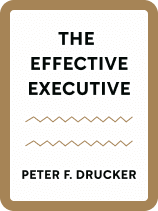

This article is an excerpt from the Shortform book guide to "The Effective Executive" by Peter F. Drucker. Shortform has the world's best summaries and analyses of books you should be reading.
Like this article? Sign up for a free trial here .
What does Peter Druker have to say on time management? How does his time management approach differ from the more conventional methods?
Peter Drucker’s time management approach consists of three steps: 1) analyze your time, 2) cut time-wasters, and 3) time block. This advice is different from what other time management books recommend in that it begins with analyzing how you currently spend your time.
We’ll explore each of these steps and how they continue to be applied today.
Managing Your Time
Executives have little unscheduled or discretionary time to begin with, Drucker writes, and they’re under constant pressure to use it reactively, dealing with whatever comes up.
In order to carve out discretionary time, Peter Drucker’s time management system is broken down into three steps:
- Analyze your time: Track, analyze, and regularly monitor where your time goes.
- Cut time wasters: Based on what your analysis tells you, eliminate, reduce, or delegate unproductive activities.
- Time block: Organize your discretionary time into blocks (90-minute units or half-days), in which you work on your contribution to the organization’s performance.
1. Analyze Your Time
Since the advent of Scientific Management in 1900 to optimize factory production, we’ve recorded and managed time spent on manual work. Identifying and eliminating wasted time has increased efficiency and lowered costs. Drucker argues that executives and knowledge workers should likewise root out wasted time to increase their effectiveness and get better results.
Peter’s Drucker’s time management approach begins with analyzing how you currently spend your time. He says it’s important to track and understand what you’re doing with your time because:
- Your sense of time is distorted: After the fact, your memory of how you spent your time will be inaccurate. Drucker notes that research shows people are terrible at keeping track of time; when isolated in a windowless room, with or without lights, they lose track of time and will under- or overestimate how much has passed (Shortform note: More recent research underscores our trouble estimating the passage of time—for instance, engrossing work and even caffeine use can make time seem to pass quickly. To combat time misperception, try four things: admit you have a perception problem, track your time, practice estimating time, and accept that you can’t totally control your time.)
- Further, what you feel you should spend your time on usually isn’t what you spend your time on. (Shortform note: In First Things First, Stephen Covey recommends closing the gap between what’s most important to us and what we actually spend our time on by learning to prioritize important things over urgent things.)
- Time is your limiting factor: Your ability to accomplish anything—your output—is limited by time, which is your scarcest resource. You can’t increase or replenish time—so you need to understand where it’s going. (Shortform note: In The 10X Rule, Grant Cardone talks about “multiplying time” by doing more in the time you have—like making 10 sales calls in 15 minutes instead of five—but that’s increasing productivity/efficiency, not necessarily effectiveness.)
Drucker’s guidelines for tracking your time are:
- Keep a log as you do things, recording everything you do and how long it takes. Do this for three or four weeks at a time, twice a year. The specific method or format you use doesn’t matter. (Shortform note: Time tracking apps such as RescueTime may be useful, particularly for automatically tracking what you’re doing on-screen—an increasingly large proportion of time use that provides myriad opportunities for distraction. Like this knowledge worker who tracked his time, you may be surprised at how little focused work you’re accomplishing.)
- After each recorded period, rethink and revise your schedule. Many people slide back into a pattern of wasting time in about six months, Drucker says, so it takes constant vigilance and adjustment to prevent this drifting. (Shortform note: The Happiness Project recommends taking daily notes about what worked—what you accomplished, when, and how, in order to identify and replicate your most productive habits and times, so you can make them routine.)
2. Cut Time Wasters
Once you’ve recorded your time for a few weeks, Drucker advises rooting out your time-wasting activities with these steps:
1) Identify and eliminate activities that don’t produce results, including things that don’t need to be done in the first place. For each item on your time record, ask yourself what would happen if you hadn’t done it or don’t do it going forward. If the answer is nothing, stop doing it. Drucker claims that most executives could eliminate about 25% of their activities without anyone noticing; he cites speeches, social events, committee memberships, directorships, and lunch or dinner events as often unnecessary.
2) Determine which activities could be done just as well or better by someone else, and delegate them. While some people view delegating as being lazy or taking advantage of a subordinate, Drucker emphasizes that as an executive, you’re being paid for your unique contribution to the organization’s performance—and when you allow yourself to be distracted from this by tasks someone else can do, you undercut your effectiveness as well as the organization’s.
3) Identify the ways in which you waste others’ time (and therefore your own). Drucker advises asking your employees and colleagues what you do that wastes their time (that doesn’t increase their effectiveness or contribution).
You may be doing something that’s productive for you but that still wastes others’ time—for example, requiring an employee to track weekly data and produce a report that you occasionally refer to but that isn’t useful to the employee creating it.
4) Cut time-wasters resulting from poor management. Drucker identifies several types of time-wasters resulting from poor management. They’re under your control and are therefore fixable:
Wasted time resulting from lack of planning. An example is the recurring crisis—for instance, the annual audit—which suddenly requires everyone’s full attention because it was left until the last minute. A recurring crisis around a regular event can be foreseen and prevented by creating a routine that administrative workers can handle. (Shortform note: Management by crisis—not the same thing as crisis management—has many downsides. The biggest is that a preoccupation with putting out fires keeps you in fight-or-flight mode, blocking the higher-order thinking needed for problem-solving. Also, it prevents you from troubleshooting future problems, planning, or communicating effectively.)
Wasted time resulting from mishandled information. Examples include:
- Information doesn’t get to the people who need it, when they need it. For instance, a production manager may neglect to inform a sales rep that equipment problems will delay fulfillment of an order—and the rep may be blindsided by a call from an angry client upset about the missed delivery deadline. (Shortform note: One antidote to the problem of information not getting to those who need it is a company-wide policy of transparency.)
- Information isn’t in a useful form. Managers who don’t get useful numbers may spend time tracking numbers and creating their own reports. (A 2018 Inc. article estimated that 73% of company data isn’t applied because it’s not in a workable form.)
- (Shortform note: An even bigger problem with mishandling information today is that it gets to the wrong people due through data breaches. This wastes enormous time and money fixing the problems and closing loopholes, and of course it squanders goodwill and credibility with clients and customers, for whom it can cause massive problems. Common causes of breaches include malware, improper employee actions including theft, and human error.)
Wasted time resulting from too many meetings. Drucker contends that one of the worst things about poor organization is that it spawns an excessive number of meetings, which keeps executives and others from getting important work done. (Shortform note: A 2017 HBR article noted that executives spend about 23 hours a week in meetings, up from 10 hours in the 1960s. Other surveys and estimates range much higher. The article points out that many meetings not only waste time but also interrupt deep work.)
Drucker says meetings should comprise no more than a quarter of an organization’s time—and if executives spend more than that in meetings, there’s a structural problem:
- A job is being spread among too many people; responsibility is unclear, or information is being shared with too many people, rather than targeted to those who need it. (Shortform note: Vague job responsibilities not only waste time, but they also cause employees stress and undermine productivity.)
- The organization’s strategy may be unclear, resulting in people doing overlapping work, or unimportant work.
- (Shortform note: An Inc. article suggests additional reasons for excessive meetings, including managers showing dominance, teams delaying work or a decision, or people protecting or trying to expand their turf.)
Drucker says meetings should be the exception rather than the rule. They are sometimes needed—people have to cooperate by sharing knowledge and information to get a specific task done. But to avoid wasting time, meetings should be purposeful and focused. In his discussion of practice #3, Drucker argues that your meetings should be focused specifically on enhancing your contribution to the organization; we’ll discuss this in detail later.
3. Consolidate and Time Block
The third step for managing your time (after analyzing it and cutting time wasters), according to Drucker, is to make the most of the little nonscheduled time you have left (your discretionary time for important tasks that contribute sign
ficantly to your company’s performance). He says this typically amounts to only 25% of your total time—you spend the other 75% on things that aren’t necessarily productive but you have to do them—for example, making client calls.
The way to make the most of this time is to consolidate it into blocks as large as possible. Drucker contends that small increments of time are useless—you can’t write a report by spending 15 minutes on it a day. If you try, you won’t get anywhere and will have to start over the next time. But if you can get four or five hours of uninterrupted time, you can create a solid draft that you can flesh out later in smaller time increments.
(Shortform note: While time blocking (also called time boxing) is widely recommended and practiced today, it was new when Drucker first wrote about it.)
Drucker suggests the following ways to consolidate your time:
- Work at home one day a week and/or work a few hours at home each morning. (Shortform note: Drucker was ahead of his time with this recommendation; in recent years, technology made working from home (WFH) more feasible, but employers resisted it until it became the norm during the Covid pandemic. Then, many remote workers found it difficult to stay focused. WFH productivity tips became popular, as well as techniques like Pomodoro, which alternates work periods with breaks using a timer.)
- Schedule operations tasks (meetings, reviews, and so on) on two days a week, then set aside the other three mornings for work on major projects with 90-minute blocks for each task. This leaves three afternoons for the unscheduled things that come up. However, Drucker recommends against consolidating minor tasks into a time block, because this reinforces a mindset of giving priority to less important things, and they nibble away at discretionary time; presumably, Drucker would delegate as many minor tasks as possible, but he doesn’t say what to do with the rest. (Shortform note: In contrast, some time blocking methods do recommend “batching” small tasks, especially similar ones, together in a block of time.)
| Time Blocking Methods Numerous books offer a variety of time blocking methods. Here’s a sampling: 1) Deep Work: Plan your day in half-hour blocks, and: Make a list of tasks you need to finish in the day.Schedule time for each task to the nearest half-hour. Be realistic, but also set a challenging deadline to force focus. Schedule time in advance for when you’ll use the Internet. Avoid it completely outside these times. Schedule overrun blocks for tasks you suspect might run overtime. Look over your schedule. If you have lots of shallow tasks (more than 30-50% time), consider how you can replace these with deeper work. During the day, if you have momentum on a task or feel particularly inspired, keep going. After you’re done, reorganize your schedule. At the end of the day, review the accuracy of your time blocks. Reflect: How well did you focus during the day? How could you focus better tomorrow? 2) The 12-Week Year: Use three types of blocks for peak performance: Strategic block: Dedicate a three-hour chuck once a week to a project that advances your strategic plan.Buffer block: Designate 30 minutes to an hour once or twice a day to handling miscellaneous activities such as email and phone calls that disrupt your workflow.Breakout block: Schedule a three-hour period weekly to rest, relax, and recharge. 3) The One Thing: Use this method to block time for your priority and treat that time as sacrosanct: Block off your vacation time for the year. Time block your One Thing (your priority purpose or task). Block off at least four consecutive hours of uninterrupted time to focus on it each day. Block an hour each week for planning time. Protect your blocked time. Time Blocking Tools Deep Work author Cal Newport has published The Time-Block Planner. Also, various tools and apps are available online—here are 10 recommended apps, including the no-frills Google Calendar. |

———End of Preview———
Like what you just read? Read the rest of the world's best book summary and analysis of Peter F. Drucker's "The Effective Executive" at Shortform .
Here's what you'll find in our full The Effective Executive summary :
- How to manage yourself before you can manage others
- The five practices that anyone can learn to be more effective
- Why leaders should purposely create disagreements






